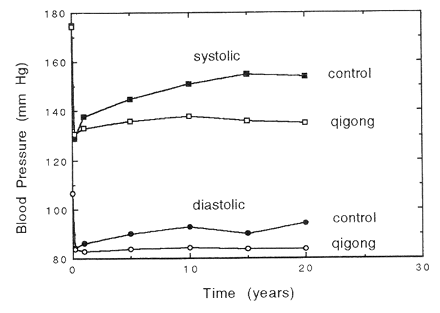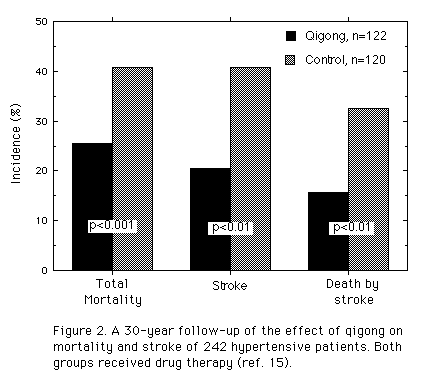Introduction
In the early 1980's, scientists in China began to study the medical benefits claimed for qigong. Since then, research on hundreds of medical applications of qigong have been reported in the Chinese literature. Of special interest for the present article are clinical reports of the medical benefits of qigong that claim to retard or reverse some diseases associated with aging.
Most of the original research was reported in Chinese, but access in English to most of this material is possible by reference to the proceedings of international conferences of qigong. Since 1986, ten such proceedings contain about 840 abstracts of talks given at the conferences, more than half of which are in English. These abstracts, along with about 160 abstracts of articles in the scientific literature, have been organized as a computerized database. The database enables searches and development of bibliographies across this entire body of information by using any key word. The clinical outcomes reported in this article are partly based on material in the database and partly on the author's person contacts with researchers.
The word qigong is a combination of two ideas: qi the vital energy of the body, and gong the skill of working of the qi. Medical qigong for health and healing consists primarily of meditation, physical movements, and breathing exercises. Qigong practitioners develop an awareness of qi sensations in their bodies and use their mind, i.e., intention, to guide the qi in the body. The benefits of qigong are said to extend beyond health and healing to enhance spiritual life and even special abilities, such as psychic powers.
Medical qigong is divided into two parts: internal and external. Internal qi is developed by individual practice of qigong exercises. When qigong practitioners have sufficiently mastered the skill, they can "emit" qi (external qi or waiqi in Chinese) for the purpose of healing another person. There are many scientific reports of the medical existence and efficacy of emitted qi. The present article focuses mainly on internal qi because almost everyone can learn qigong exercises for maintaining health and for self-healing, whereas, there are a limited number of skilled qigong masters available for healing.
There are numerous reports of the effects of emitted qi on living systems and the functions and organs of the human body. The present author reviewed some examples of medical applications of qigong and emitted qi on humans, animals, cell cultures, and plants, and he also published some of his experimental research on physiological effects of qigong. He discussed some clinical and experimental evidence showing that qigong exercise and external qi affects various functions and organs of the body. A short list of some of the functions and organs affected by qigong, and the measurement techniques employed (in parentheses), include: the brain (EEG and magnetometer); blood flow (thermography, sphygmography, and rheoencephalography); heart functions (blood pressure, EKG, and UCG); kidney (urinary albumin assay); biophysical (enzyme activity, immune function, sex hormone levels (laboratory analysis); eyesight (clinical); and tumor size in mice.
Clinical studies indicating the anti-aging benefits of qigong
Several clinical studies will be described to illustrate the scope of research on medical applications of qigong to treat chronic medical conditions that may affect the aging process. Some details may be omitted because of space limitations. The critical evaluation of the research studies will be left to medical specialists.
1) Therapeutic balancing of the meridians and functions of the body by qigong
The profound effect that internal qigong practice may have on balancing the energies of the organs and functions of the body is illustrated by measurements using Electroacupuncture According to Voll (EAV). In EAV the electrical conductance of the skin above individual acupuncture points is measured using low voltage and low current. Diagnosis depends on measuring the relative electrical conductance and its time dependence. An important diagnostic criterion of degeneration of an organ is an "indicator drop" that may occur during the measurement when the conductance reaches an apparent maximum value but then decreases before leveling off.
Measurements were made at 24 acupuncture points at the ends of the 12 meridians in the fingers and toes of subjects and were made by the same operator and equipment. The subjects were asked to perform a qigong exercise of their choosing for 10 to 15 minutes, for example, sitting or standing meditation or moving qigong. Two series of EAV measurements were made before and after healthy subjects practiced qigong.
In the first series, four subjects were examined by EAV before and after they practiced qigong. Qigong exercise decreased the average of the EAV measured values of the four subjects in the range of -19 to -31% (p<0.004). Qigong eliminated almost all the indicator drops.
In the second series, each of seven subjects was examined by EAV three times in a blind protocol so that the operator did not know whether a subject had practiced qigong before the second or third examination. The results showed that qigong exercise changed the average EAV measured values in the range of -17 to -35% for four subjects and in the range of 4 to 15% for three subjects. Indicator drops again were markedly decreased.
These preliminary results show that internal qigong practice can make significant changes in the therapeutic balancing of the meridian and organ systems.
In a similar type of study, the electric current at acupuncture points on 14 meridians was measured using a single square wave voltage pulse technique. Both a qigong master, who emitted qi, and a qi-receiver were measured simultaneously and continuously. The results show that internal and external qigong produce different values in some measurement parameters, and also some synchronous behavior was observed between the sender and receiver.
2) Clinical studies of effects of qigong on hypertensive patients
Several groups in China have investigated the effects of qigong on hypertension (i.e., high blood pressure). The research of Wang, Xu and coworkers of the Shanghai Institute of Hypertension was selected for discussion because it serves as a model for the many different effects that qigong may have on organs and functions of the body. For these studies, the patients practiced "Yan Jing Yi Shen Gong" for 30 minutes twice a day. This qigong is claimed to be especially valuable for therapeutic purposes and delaying senility. The qigong exercise consists of a combination of sitting meditation and gentle physical movements that emphasizes a calm mind, relaxed body, and regular respiration.
In 1991, the Shanghai group reported a 20-year controlled study of the anti-aging effects of qigong on 204 hypertensive patients. Subsequently, they reported a 30-year follow-up on 242 hypertensive patients, and more recently, the researchers reported an 18-22 year study of 536 patients. The patients were randomly assigned to the two groups. To control blood pressure, the patients were given the same hypotensive drug and in the same hospital. None of the patients smoked.
a. Blood Pressure
The effect of qigong exercise on blood pressure is shown graphically in Fig. 1. The blood pressure (systolic and diastolic) in millimeters mercury is plotted as a function of time over 20 years for the group consisting of 242 patients, 122 in the qigong group and 120 in the control group. During the first two months, the blood pressure of all patients dropped in response to the hypotensive drug. Subsequently, and over the period of 20 years, the blood pressures of the qigong group stabilized while that of the control group increased. Remarkably, during this period the drug dosage for the qigong group could be decreased, while the dosage for the control group had to be increased.
 Fig. 1. Effect of qigong on blood pressure of hypertensive patients over 20 years. Qigong group (n=104) practiced 30 min/day twice/day, control group (n=100).
Fig. 1. Effect of qigong on blood pressure of hypertensive patients over 20 years. Qigong group (n=104) practiced 30 min/day twice/day, control group (n=100).
b. Mortality and Stroke
The incidences of mortality and stroke for the 30-year study are shown in Fig. 2. These results show that qigong exercise decreased by about 50 percent the incidence of total mortality, mortality due to stroke, and morbidity due to stroke. At the end of 30 years, 86 patients survived in the qigong group and 68 in the control group. These results clearly show that qigong has significant potential for preventing strokes and extending life.

c. Improvements in heart function and mircrocirculation
Aged hypertensive patients usually are found to have a deficiency of Heart-energy, which often leads to a weakened function of the left ventricle and a disturbance of microcirculation. The researchers evaluated the effects of qigong for120 aged patients by using ultrasonic cardiography (UCG) and indices of microcirculation.
Experiments showed that the left ventricular function (LVF) in the hypertensive aged group (80 cases) was lower than that in the aged normal blood pressure group (40 cases), while the LVF in the deficiency of Heart-energy hypertensive patients (46 cases) was lower than in the non-deficiency Heart-energy hypertensive patients (34 cases).
After practicing qigong for one year, cardiac output was increased, the total peripheral resistance decreased, and the ejection fraction mitral valve diastolic closing velocity and the mean velocity of circumferential fiber shortening tended to be increased. Significant changes did not occur in the group without Heart-energy deficiency.
Quantitative evaluation of nailfold disturbances in microcirculation was made on the above groups by observing 10 indices of abnormal conditions: configuration of micrangium, micrangium tension, condition of blood flow, slowdown of blood flow, thinner afferent limb, efferent limb and afferent limb ratio, color of blood, hemorrhage, and petechia. The results showed that hypertension had an accelerating effect on the disturbance of microcirculation. The incidence of disturbance of microcirculation disturbance was 73.9% in the deficiency of Heart-energy hypertensive patients. After a year of qigong practice, the incident of disturbance was 39.1% (p<0.01).
The results suggest that qigong exercise has beneficial effects on Heart-energy and regulation of the blood channel, and qigong seems to have improved abnormal conditions of blood circulation.
d. Improvement in sex hormone levels
One consequence of aging is that the levels of sex hormones change in unfavorable directions. For example, female sex hormone (estrogen) levels tend to increase in men and decrease in women. Three studies indicate that qigong exercise can reverse this trend. The effect of qigong exercise on plasma sex hormone levels was determine for hypertensive men and women. The sex hormones levels were measured before and after qigong practice for one year.
Seventy male patients with essential hypertension (ages 40 to 69; disease stage II) were divided into two groups. For the qigong group (n=42), which practice qigong for one year, the estradiol level (E2) decreased from 70.1 to 47.7 pg/ml, a decrease of 32% (p<0.01), while no significant changes occurred in the control group (n=20). The testosterone levels (T) of both groups decreased about 7%. The value of E2 for the qigong group (47.7 pg/ml) approached that of healthy men (42.2±5.8 pg/ml) of the same age but without hypertension or cardiovascular, pulmonary, hepatic, renal, or endocrine diseases (p<0.05).

For women (ages 51 to 67, the number in the group is not available), the aging process was associated with failure of ovarian function manifested by decreased E2 and increased T levels. Qigong practiced one year resulted in an increase of E2 from 40.9±.3.5 to 51.6±3.5 pg/ml, a value about equal to that of normal menopausal controls without hypertension or cardiovascular, pulmonary, hepatic, renal, or endocrine diseases. The value of T was also increased by qigong from 25.5±2.2 to 37.2±2.2 ng/dl.